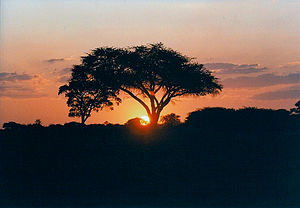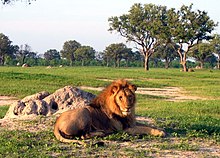Hwange National Park
|
Hwange National Park
|
||
|
Sunset in Hwange National Park |
||
| location | Matabeleland North , Zimbabwe | |
| surface | 14.651 km² | |
| WDPA ID | 1991 | |
| Geographical location | 18 ° 45 ′ S , 26 ° 0 ′ E | |
|
|
||
| Setup date | 1930 | |
| administration | Zimbabwe Parks and Wildlife Management Authority | |
The Hwange National Park ( English Hwange National Park ; formerly Wankie National Park ) is the largest national park in Zimbabwe with 14,651 square kilometers . The park is located in the west of the country in the foothills of the Kalahari on the border with Botswana, 200 km northwest of the city of Bulawayo . The park, which is rich in biodiversity, is one of the most important nature reserves in the country. It is part of the Kavango-Zambezi Transfrontier Conservation Area .
history
The area is said to have served as a manorial hunting area for King Mzilikazi as early as the 19th century . As early as 1928, the area was placed under nature protection by the British colonial administration as a wildlife reserve. In 1930 it received the status of a national park. The national park is named after a local tribal leader.
Abiotic environmental factors
The national park lies in the transition area from the Kalahari desert in the southwest to the more humid savannas in the northeast. The altitude ranges from 938 meters to 1152 meters. About two thirds of the area is occupied by sandy soils, which are divided by fixed dunes and dry river valleys running to the southwest. There is a layer of cast stone under the sand . In the north, the soils arose from the rocky subsoil, this part drains north to the Zambezi .
The annual precipitation is about 655 mm, decreasing to the southwest. The rain falls mainly in the months of November to March. Most bodies of water are temporary, salt accumulates. The hottest temperatures are reached before the rainy season, in October. June and July are the coldest months, with occasional light frosts.
Vegetation and flora
The vegetation changes analogously to the precipitation from the desert-like southwest to the tree-lined northeast. On the dry sandy soils, hardened by local stone, there is grassland with individual camel thorn acacias ( Acacia erioloba ). The east is more densely overgrown, with Baikiaea plurijuga , Baikiaea africana , Guibourtia coleosperma and Pterocarpus angolensis on higher trees . Terminalia sericea , Combretum and Acacia species grow in the undergrowth . In the north, with better water and soil conditions, Mopane forest grows with Mopane ( Colophospermum mopane ), Combretum and Commiphora species.
fauna
In the park populations consist of African elephants ( Loxodonta africana ), African buffalo ( Syncerus caffer ), giraffes ( Giraffa camelopardalis ), Burchell's zebra ( Equus burchelli ), hippos ( Hippopotamus amphibius ), desert warthogs ( Phacochoerus aethiopicus ), a large number of antelope , including Wildebeest , greater kudu ( Tragelaphus strepsiceros ), impalas ( Aepyceros melampus ) and sable antelopes ( Hippotragus niger ). Other existing mammals are lions ( Panthera leo ), leopards ( Panthera pardus ), cheetahs ( Acinonyx jubatus ), African wild dogs ( Lycaon pictus ) and two species of hyenas .
Existing species, genera, and are -families in dependence on the season waxbills (Estrildidae) Girlitze (Serinus), pigeons (Columbidae) Frankoline (Francolinus), guinea fowl (Numididae), grouse (Pteroclididae) and Stare (Sturnidae) during the Dry season . During the rainy season, keep cuckoos (Cuculidae), swallows (Hirundinidae), sailor (Apodidae), flycatchers (Muscicapidae) Nightjars ( Caprimulgus ), Egyptian Geese ( Alopochen aegyptiacus ), Rotschnabelenten ( Anas erythrorhyncha ) and bumps gloss geese ( Sarkidiornis melanotos ) there on.
Existing raptors are jugglers ( Terathopius ecaudatus ) and ears Geier ( Torgos tracheliotus ), white-rumped vulture ( Gyps bengalensis ), Cape Vulture ( Gyps coprotheres ) Wollkopfgeier ( Trigonoceps occipital ) and hooded vulture ( Necrosyrtes monachus ).
In order to maintain the animal population in the dry season, 62 artificial wells were drilled. Migration of the animals to the more humid northeast, to the Gwayi River, is interrupted by settlements. In addition, the park is fenced in to contain the transmission of foot-and-mouth disease .
The population of elephants was estimated at 2000 to 4000 animals around 1930. By 1985 the number had increased to between 12,000 and 14,000 animals. In 2006 the estimates were between 30,000 and 40,000 elephants. In 2017, the population was given as around 23,000 animals. The population is also supported by the artificial water points, but the death rate increases significantly in dry years. The elephants cause changes and disturbances of the vegetation locally.
Management and poaching
Camps with branch offices of the national park administration are located in Robins, Sinamatella and at the portal of the park (Main Camp) .
A total of 81 elephants were killed in 2013 after the herd's watering holes were poisoned with cyanide in two different events . As a result, nine poachers were arrested and large quantities of ivory were seized. The number of smaller animals killed by the poison and the number of predators that ingested the poison indirectly was not fully recorded statistically.
The killing of the lion Cecil at the beginning of July 2015 caused a sensation . The lion with the distinctive black mane was considered a symbol of the national park and was well known among visitors and locals. A dentist from the USA has testified to have hunted the lion with a bow and arrow. He paid US $ 55,000 to kill a lion , hired a local safari agency and assumed that killing the lion was therefore legal. According to newspaper reports, its leaders lured the lion with a carcass . Outside the boundaries of the safe national park, the lion was wounded with an arrow by the American, and Cecil was not found until forty hours later and was killed by a gunshot. The lion was part of a research program at the University of Oxford , and neither the hunter nor his assistants claim to have noticed the GPS collar. After Cecil was shot, his head was severed and the hide peeled off. The hunters tried in vain to destroy the collar and then hid it in a tree. The head and fur, which have already been prepared for preparation , have now been handed over to the authorities. The American hunter, the head of the safari agency and the owner of the property where the lion's carcass was found have been charged with poaching by local authorities. The case met with great sympathy around the world. Animal welfare organizations and many celebrities, including Arnold Schwarzenegger , Amy Macdonald , Ricky Gervais , Nicky Rothschild and Mia Farrow , condemned the hunter and called for an end to the trophy hunt .
See also
supporting documents
- ↑ Wankie National Park , accessed November 11, 2015
- ↑ a b c d e f g h i j Hwange National Park. (No longer available online.) World Conservation Monitoring Center, 1985, archived from the original on April 24, 2009 ; accessed on February 19, 2018 .
- ↑ a b c Hwange National Park. (No longer available online.) Zimbabwe Parks and Wildlife Management Authority, archived from the original September 4, 2010 ; Retrieved August 31, 2010 .
- ↑ 2017 GAME CENSUS FOR HWANGE NATIONAL PARK AND SURROUNDING AREAS. ZimParks, 2017 (English), accessed April 15, 2018
- ↑ N. Owen-Smith, GIH Kerley, B. Page, R. Slotow, RJ van Aarde: A scientific perspective on the management of elephants in the Kruger National Park and elsewhere . In: South African Journal of Science . No. 102 , 2006, p. 389-394 ( up.ac.za [PDF]).
- ↑ Hwange | Zimparks. Retrieved May 23, 2019 (American English).
- ↑ Elephants in Zimbabwe poisoned with cyanide from www.bbc.com, accessed on August 1, 2015
- ^ Lion Cecil killed in the Hwange National Park on www.sueddeutsche.de, accessed on August 1, 2015
- ↑ Press release ( memento of August 2, 2015 in the Internet Archive ) on www.zimparks.org.
- ^ Petition: Justice for Cecil at www.thepetitionsite.com, accessed August 1, 2015
- ↑ These are not trophies , Arnold Schwarzenegger on twitter.com, accessed on August 1, 2015
- ↑ Löwen-Shitstorm at www.abendzeitung-muenchen.de, accessed on August 1, 2015
- ↑ Celebrities outraged by the killing of the lion Cecil on www.stern.de, accessed on August 1, 2015
Web links
- Zimbabwe Parks & Wildlife Management Authority: Hwange National Park Overview . on www.zimparks.org (English)
- Wildlife & Environment Zimbabwe: Reports from previous Game Counts . at www.wezmat.org (English)



